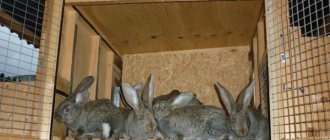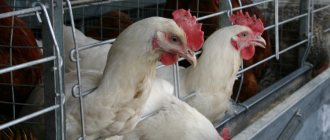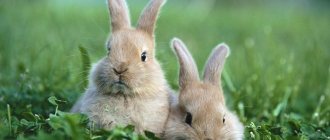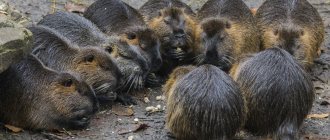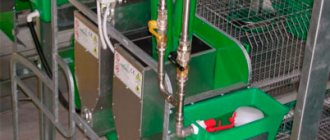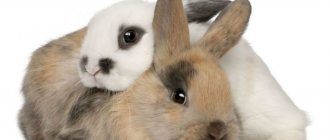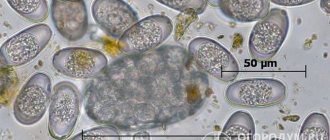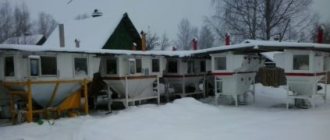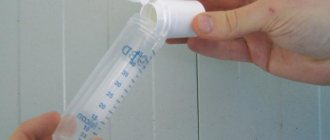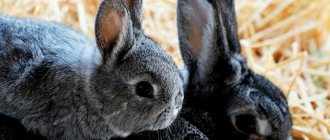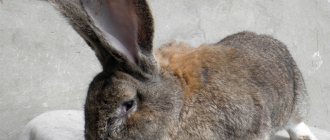The farmer will need cages for fattening rabbits after weaning the rabbits from the female. The young animals will remain in them until slaughter. When building rabbit houses, you should take into account the size, since several individuals live adjacent to one cage. The main requirements for such structures are the safety of pets and ease of maintenance.
Rabbit cages for fattening
Features of fattening cages
Rabbits stay in the same territory with their mother until they reach the age of one month. Some plant young animals later, after 45 days. During this period, babies already eat adult food and become independent.
After the end of lactation, the rabbits are provided with separate housing - fattening houses. They contain babies of the same sex, 4–8 individuals each. Pets of different sexes can be kept together for up to 3 months, but after that they will still have to be separated .
During puberty, males and females should not be kept together, otherwise they will mate. Mature males will also have to be placed in single cages. Mature males fight for territory and can injure and even kill each other. Young females are quite capable of getting along if they are taken from the same litter or kept in the same cage from an early age.
Feeding houses are a place where young animals live until they reach sexual maturity or before slaughter . Their features:
- The area allocated for 1 individual does not exceed 0.25 m2. In spacious cages, pets move a lot, which negatively affects the quality of meat.
- The owner of the animals should be comfortable caring for them - distributing food and cleaning.
- Inside the cages there is a feeder for mixed feed and a manger for hay, and the home is also equipped with a drinking bowl.
Attention! Each young individual drinks about 200 ml of water per day. The drinking bowl should satisfy the needs of all pets living in the house.
Cell sizes and rod diameters
Experienced rabbit breeders recommend using two types of mesh when building rabbit cages of any design:
- square cells - 2*2 cm, rod diameter - 0.4 cm;
- rectangular cells - 2.5 * 5 cm, rod diameter - 0.2 cm.
You should know that the size of the cells depends on the size of the animals and their breed. For large breed rabbits, you should choose a coarse mesh.
Find out how to make your own for rabbits: a cage, a queen cell, a shed, a barn, a house, a drinking bowl, a feeder and a hay barn.
A cage for one adult should be of the following dimensions:
- length - 128 cm;
- width - 80 cm;
- height - 44 cm.
If you plan to keep several rabbits in one cage, then each pet should have at least 120 square meters. cm of the total area. Crowding of animals in close spaces can lead to fights among males, crushing of young animals and the spread of various diseases in rabbits.
Dimensions of feedlots
Before starting the production of cells, it is necessary to determine their parameters. It is considered normal if an area of at least 0.12 m2 is allocated for one rabbit. Based on this, the cell sizes are calculated. So, for 6–8 pets, a structure 1.2 m long and 0.7 m wide is suitable. The height should be half a meter or a little more.
Design of a cage for fattening rabbits
When the time comes to place the males, you need to take care of a separate home for each of them. In this case, bulk cells will not be needed. It is enough to build a structure of 35x40 cm with a height of 50 cm. For female rabbits kept in pairs, a square cage of 50x50 cm is suitable.
Progress
Even if mesh cages for rabbits are designed to contain one individual, they need to be made large: rabbits are active animals, they need space. It should be clarified that the proposed design of the mesh cage is not suitable for the queen cell; it is recommended to attach it as a separate structure.
After all measurements have been made, you can begin assembly.
Cuts on the mesh must be smoothed with a file to avoid injury.
- To make the door, use a mesh for rabbit cages. The height and width of the segment must exceed the dimensions of the doorway. The doors are secured with two rings. The outer part is equipped with a bolt.
- For an outdoor cage, the frame is covered with additional materials: plywood, slate. Then the upper part is made with gaps on all sides of at least 40 mm.
- The final stage is the installation of feeders, water supply and drinking bowls. Experts recommend making them outdoors, this makes them easier to care for and simplifies the feeding process.
Read also: Flanders rabbits (or Belgian giant)
When making cages for rabbits, the use of fasteners, mats and other plastic elements is not recommended. The animal will definitely chew on these parts and fill its stomach with plastic shavings.
To summarize, there are several important points to highlight.
- Rabbit mesh is the most suitable material for making cages.
- To make a rabbit cage, you need to choose a welded galvanized mesh.
- To avoid injury, the floor mesh is selected with smaller cells, and the cuts are leveled.
- Plastic cannot be used.
- Outdoor cages are insulated on the outside with plywood.
It’s easy to make a high-quality cage for rabbits that will last a long time if you put in the work and follow the recommendations.
Preparation for construction
So, the dimensions of the house have been determined. Now you need to choose the material for construction. Farmers prefer to make feeder cages from plywood or mesh. Some people use scrap materials - remnants of chipboard, old furniture. It is better to make the floor mesh so that pet excrement falls down into a tray, which is usually made of galvanized sheet or plastic. Then the inside will always be clean.
Attention! To construct cages, it is better to use galvanized mesh, which is not susceptible to corrosion.
Preparation for construction includes the creation of a drawing. Having decided on the dimensions, you need to transfer the plan of the fattening houses to paper. The diagram shows all measurements.
Materials and tools
To build feeding houses for rabbits you will need the following materials:
- beam;
- mesh with small cells;
- wooden slats with a section of 20x40 mm;
- rivets;
- nails;
- self-tapping screws;
- sheet of tin for the pallet;
- hinges for the door and latch.
This list of materials is used if a decision is made to make rabbit houses from mesh on a wooden frame. However, the walls of the structure can also be made of plywood or other material, at the request of the farmer.
Tools and materials for cell construction
You will need a standard set of tools:
- hammer;
- wire cutters;
- screwdriver;
- file;
- to work with wood you need a saw;
- roulette;
- level.
Step-by-step instruction
The manufacturing process of this rabbitry format is extremely simple. The main thing is to adhere to the exact algorithm and dimensions indicated in the drawing during the work. The assembly is performed according to the following instructions:
- From a solid mass of galvanized mesh, all the elements outlined in the diagram with the corresponding dimensions are cut out with scissors. In the case of a frame structure, these will be longitudinal and end walls. To make a frameless model, you also need to cut out the floor and ceiling.
- Small staples are made from galvanized wire using pliers.
- Wall blanks are connected to each other with staples.
- Then the floor and ceiling are fixed with the same brackets. The floor is additionally reinforced with a wooden block, packed every 40 cm.
- If you plan to keep a female rabbit with her young in the enclosure, then the floor of the nesting compartment is sewn up tightly.
- Depending on the number of animals in the cage, mesh partitions are placed inside.
- A square opening for the door is cut out on the front wall. The latter is also made from mesh, but with a slight overlap beyond the opening. They fix it on rings made of wire.
- A stand with a height of at least 1.2 m is made from the corners.
- The roof is covered with metal profiles or slate.
Important! You should also provide removable plywood panels for the winter. They will protect animals from precipitation and cold.
A mesh cage for rabbits differs from other designs in a number of advantages. Its assembly costs less than assembly of wooden structures. Grilles allow light and air to pass through better. The cage takes up less space and is much easier to clean. In addition, the design of the product is so simple that even an inexperienced novice rabbit breeder can assemble it within an hour.
Detailed instructions for making fattening cages
First you need to build a frame for the future structure. To do this, cut the bars to the required length. They are connected to each other along the perimeter using self-tapping screws. Then vertical supports are installed, which are attached to the base at right angles. The door is located at the front of the house. You will have to make a frame from timber of the appropriate size.
Attention! It is important to note that the cells are usually raised above the ground to a convenient height of 50 to 80 cm.
The next step is cutting the mesh into the required fragments, according to the drawing. The finished rectangles are attached to the wooden frame with rivets. Having finished the casing, attach the hinges and fix the door on them. A pallet is installed at the bottom of the cage under the mesh floor, cut out of tin or galvanized sheet. The outer edges are folded inward.
The floor does not have to be mesh. Many farmers make it from wood. To do this, narrow slats are stuffed onto the frame, leaving a distance of 1–1.5 cm between them. Pets feel comfortable on this floor, their paws are not injured, and feces fall into the tray through the cracks.
Attention! If the cages for young animals will be placed outside, a roof will be needed. It is done at an angle. Suitable roofing material is slate.
A feeder is placed inside the finished structure. It is attached to one of the walls of the house to avoid tipping over. The cage is equipped with a manger for hay and a drinking bowl of suitable volume. It is convenient to use a nipple one, since the water in it always remains clean. The container is secured on the outside of the house, and the nipple is brought inside.
Arrangement of the cage inside
Housing for rabbits can have one spacious room or two sections: feeding and nesting. If the nesting compartment in the cage for females is not fenced off, then before breeding a queen cell is placed in it, that is, a closed plywood box with a hole 30 cm in diameter. A feeder, a hay barn and a drinking bowl are installed inside the structure. These items are made from plastic, wire, sheet metal or wood.
True, animals will quickly chew through thin plastic; it is better not to use it.
Feeders are installed near the door, front wall or suspended from the front partition. For hay, they buy or make their own wire feeders, which are taken outside the perimeter of the cage, that is, hung on the door or side, front wall. The drinking bowls are also attached to the front mesh partition. You can buy ready-made water supplies at a hardware store. For example, vacuum or nipple drinkers for rabbits.
The cage should also have enough space for the animal to be active. Some craftsmen make multi-tiered structures for their pets. At the top they set up a nest, at the bottom they make a feeding area with a spacious walking area. You can keep rabbits in wooden boxes in a warm room in winter, and in summer you can move them outside to a portable pen made of chain-link mesh, where they will eat pasture.
Features of the feedlot
Young, grown-up rabbits are separated from their mother at the age of 30-45 days. By this time, the rabbit’s lactation has completely stopped, the babies are already growing up enough, gaining a certain weight and are ready to eat on their own. At this age, the question arises about the relocation of the younger generation to other cells. Rabbits can be placed either one at a time in adult cages or in intermediate common cages. If you choose a hostel for 5-10 teenagers, you should make sure that the animals are same-sex.
The dimensions of the joint cage should be approximately the following: 120x70x50 cm. At the same time, each resident should have at least 0.12 sq.m. Simple mathematical calculations can determine that no more than 8 rabbits can be accommodated in one joint “apartment”. If we are talking about giants - no more than 5-6.
Even if you choose joint fattening, at the age of 3-4 months the rabbits will still have to be placed in separate “apartments”. Males, entering puberty, will not be able to get along even in twos. Constant fighting can lead to serious injury and even death to one of them. Young females get along in groups of two. A single apartment should have approximate dimensions of 35x40x50 cm, and in a cage 50x50x50 cm you can keep animals in pairs.
The features of the feeding house are to prevent the rabbits from actively moving, and to give the owners the opportunity to feed and serve the residents without any problems. Young animals for fattening are kept only on mixed feed and sometimes on hay. This should be taken into account when designing feeders. In addition, pets must have enough water, so it is worth providing a nipple drinking system or regularly changing their water manually.
Types of construction
Before you start building a rabbit cage, you need to decide where exactly you plan to install it. There are two types of construction - frameless and framed (street view). Let's look at both options in more detail.
Important! When creating a house for rabbits of any design, do not use plastic. Animals can easily chew it and get poisoned or get more serious injuries.
Frameless design
Such houses are used when raising rabbits indoors - their compact size allows you to save space. In its manufacture, only metal mesh is used, and the structure itself is installed on a stand, for example, a table or window sill.
Outdoor cages have a more complex structure - a frame of wooden beams or metal rods is added. A canopy must be installed under which the animals can shelter from bad weather.
Read also: Purebred riding horse breed
Video “How to make a feedlot with your own hands”
In this video you will learn about the features of another type of mesh feedlot. A cozy house of this type can also be useful for a novice rabbit breeder.
Find out more
Making a pen for rabbits
Shed keeping rabbits in the household
We independently build hay nurseries for rabbits
Raising rabbits for meat is carried out both on large farms and in households. The breed of animals, as well as the characteristics of keeping rabbits, are the determining factor when choosing a feeding method.
Compliance with stage-by-stage feeding gives a high-quality product at the end.
We make cages for rabbits using a mesh with our own hands
Their health, fertility, weight gain, and fur quality depend on the living conditions of rabbits. Therefore, they need a comfortable, safe home. Mesh cages for rabbits are an ideal option. They are easy to use, provide good ventilation and are safe. You can make a mesh cage yourself using the tips offered in this article.
Read also: How and what to treat scabies in cows
Meat breeds of rabbits
Fattening rabbits for meat will become a profitable business only if the breed is chosen correctly.
New Zealand white rabbit
The meat type is characterized by the following characteristics:
- rapid growth and stable weight gain;
- high rate of pure product;
- excellent taste of meat.
Not all types of young rabbits are used for breeding and subsequent slaughter.
Meat breeds of rabbits suitable for fattening include:
- New Zealand white. By 5-6 months the animal’s weight is 5 kg. During the birth, 9-11 cubs appear. Rabbits can be kept in boxes with mesh flooring.
- New Zealand red. The female is larger than the male. Rabbits gain weight well. The yield of pure meat reaches almost 60%.
- Gray giant. Maximum weight – up to 6 kg. A female rabbit can give birth to up to 8 cubs. The breed is characterized by early maturity. The quality of the meat is good.
- Californian breed. It is distinguished by early ripening. During the year, one female gives birth to more than 30 cubs. The taste characteristics of meat and the density and density of wool are valued by consumers.
- Poltava silver. The breed is valued for its fluffy fur. Animal meat is pleasant and soft in taste.
- Ram (or lop-eared rabbit). Weight at the time of slaughter is about 8 kg. In one litter, the female brings 7-9 pieces. Rabbit meat tastes tender and light.
- Flanders Animals reach a length of 70 cm. Body weight is up to 10 kg. The meat is juicy and tasty. The breed is a late ripening breed; breeding requires a wide cage and constant care.
Rabbit breeders prefer the New Zealand white, gray giant and Californian breed.
Drawings and photos of cages for rabbits
Photo of a wooden cage for raising rabbits on a home plot with dimensions
Cage for three adult rabbits (for home keeping). Consists of two levels. The lower level has double doors that open wide for easy access to the cage. The upper level consists of two separate compartments connected by an entrance. One of the cage compartments is designed for rabbits to sleep. The other compartment is covered with mesh and this area can also be opened for easy access (great for cleaning the cage and for grooming and feeding rabbits). The design of this cage is quite simple, and you can make it yourself to keep rabbits in your garden.
The photo shows rabbit cages made of wood and metal mesh
Photos of cages with walking for rabbits
Drawings of cages for rabbits and their young
Drawing of an adobe cage (1), a wattle-clay cage (2), a combined cage with a run for keeping rabbits (3), a cage from a box (4)
Drawings of cages for keeping rabbits at home
Fattening rabbits for weight gain
Plant and feed impurities are introduced into the food of rabbits from 2-3 months. The composition of feed at each age stage is different.
Without special fattening, the farm will not only remain without profit, but will not even recoup the costs of maintaining the long-eared animals.
The process of feeding rabbits involves three stages:
- preliminary (selection of a suitable diet);
- main (weight gain in pets);
- final (adjustment of weight and body fat).
The first period is characterized by increased nutrition of young animals.
In summer and winter, it is based on combined mixtures:
The preparation stage is 5 days.
The main stage is aimed at the formation of the fat layer.
Animal nutrition includes foods containing fats:
Porridge with milk is added to the rabbits' daily diet. The fattening period lasts 7-10 days.
The final stage involves maintaining the animals' appetite.
The liquid is salted, and seasonings from:
Constant monitoring is carried out to ensure that pets eat the required amount per day.
In the last days of feeding, hay and grass are excluded.
Amount of feed for fattening
The use of exclusively mixed feed is typical for industrial fur farms. For a mature individual, consumption per day is 100-110 g of feed, in which 55% is grains, corn, oats, 45% is cake and bran.
The nutrition of rabbits becomes complete due to the inclusion in the daily diet, in addition to compound feed, of auxiliary feeds, which are divided by type:
- green - a combined group of fresh plants (grass, tree leaves);
- juicy – represented by fruits and vegetables;
- coarse - hay.
Attention! The need for concentrated feed depends on the time of year, gender and age of the animal.
With mixed feeding, the dosage of feed per day is half as much (40-50 g), with the exception of:
- female puppies, who are prescribed 90 g in summer, 100 g in winter;
- nursing rabbits - 130 g in summer, 150 g - in winter.
Table 1. Annual feed requirement for combined fattening
| Type of individual | Stern | Quantity (kg) |
| Compound feed | 342 | |
| Hay | 109 | |
| Silage, root crops | 90 | |
| Fresh grass | 420 |
Feeding cages for rabbits
The dimensions of the feeding cages are determined by:
- number of young animals;
- number of mature rodents;
- place where animals are kept.
General principles for organizing animal housing:
- Thoughtful location of the territory for maintenance (without drafts and strong winds).
- The choice of wood as a material for the frame and supports, for the walls - plywood or mesh.
- Keeping males separate from pregnant female rabbits and their joint offspring.
- Typical cage parameters for an adult are 1500x700x700 mm.
Table 2. Minimum sizes for keeping pets
| Classification | Standard area per head (sq. m) | Length(cm) | Width(cm) |
| For the main herd (two-section) | 1st section – 0.5-0.62nd section (nesting compartment) – 0.18 | 60-7050 | 9036 |
| For females (for 4 individuals) | 0,15 | 90 | 672 |
| For males (for one) | 0,605 | 90 | 672 |
| For young animals | 0,13-0,16 | 29-36 | 45 |
Interesting ideas for unusual cells
If you wish, you can build a real house for your animals with several rooms: a bedroom-nest, a kitchen-feeding area and a huge living room, that is, a place for walking. Some craftsmen make two-tier structures for rabbits. In the lower tier, instead of a floor, there is green grass, and the walls are made of a frame covered with mesh. At the top there is a wooden closed box for sleeping. The animals climb to the second floor along an inclined board-ladder.
You can make a cage for your animals in the form of a village house, where the balcony is a feeding trough for hay and grass, and the windows are openings with mesh in the side walls. On top of such a house there should be a roof covered with waterproofing roofing material. In winter and summer, such a structure can be placed outdoors.
A cage with an animal can be made from high-quality wooden materials and placed on a raised platform near the fence. It is better to make doors from mesh. On a flat roof you can place pots of flowers or a tray with fragrant plants (dill, parsley, celery) that rabbits love so much.
How long does it take to fatten rabbits?
The technology of breeding rabbits for meat provides for three types of fattening from birth to slaughter:
- long-term feeding (120 days);
- optimal fattening (90 days);
- early fattening (less than 70 days).
The first option is used for raising rabbits at home. A short-term approach has a bad effect on the quality of the product. Animals should be fed for 3 months.
From birth to 4 weeks, rabbits grow rapidly. Body weight increases from 40-80 g to 500-700 g. Starting from the 5th week and within 1.5-2 months, rabbits increase their weight.
After 50 days, the growth of the animals gradually slows down. The acceptable age of an animal for slaughter is 84-90 days.
Mesh cage options for rabbits
Rabbit cages made of metal mesh have a wide range of advantages, the main ones being the following:
- ease of assembly at home;
- quick and comfortable cleaning of the structure;
- possibility of location in limited space;
- product durability.
But it is worth noting that such designs of rabbit cages are not suitable for any method of keeping. They are used only as a summer home for animals or when kept indoors all year round. Moreover, each method of breeding animals involves its own version of the design of mesh structures.
One-piece mesh
The product, made exclusively from mesh, is used when rabbits are indoors all year round. In this case, the animals are already protected from precipitation, cold and strong winds that can damage the structure. Therefore, a strong, stable frame is not needed here, and the mesh walls and ceiling of the product allow light and clean air to enter freely.
One-piece designs must be installed on durable stands. When placing the cage directly on the floor, the living creatures will freeze in winter. In addition, when cleaning, all the dust will fall into the enclosure. Also, the design is often supplemented with lamps located directly above the mesh house.
The main advantages of the frameless option are ease of assembly and minimal space requirements for placement.
On a frame
Frame designs are used mainly for raising livestock outdoors. In this case, first a strong frame is made from wood or metal rods, onto which the mesh is then mounted.
Frame cage
Without fail, this design is complemented by a roof made of slate or metal profiles, as well as a strong stand. As a result, such a product offers the following advantages:
- resistance of the structure to strong winds and physical impacts;
- protection of living livestock from precipitation and scorching sun rays;
- high mobility, which is implied by the low weight of the constituent elements of the structure;
- the possibility of arranging several enclosures in two or three tiers.
Methods of raising rabbits for meat
Animal nutrition is the basis of rabbit breeding.
Two methods are used for fattening rabbits:
In large and medium-sized farms containing 200 animals or more, both technologies are being introduced simultaneously. In homesteads, the usual method of feeding is used.
Broiler method of breeding rabbits
The peculiarity of the method is the short period of feeding the young animals and the savings on cages. One fattening cycle takes 90 days.
Feeding rabbits at home is not complete without hay and branches of various trees.
During feeding, the rabbits remain with their mother. After finishing fattening, the female is transferred to the male for mating. In a year, a female rabbit gives birth to up to 24 babies.
This is interesting! The skin of broiler rabbits is inexpensive, but the meat is in great demand due to its nutritional value and taste.
Advantages of the broiler method:
- there is no need to equip group cells;
- concentration of livestock in one place allows for quick care of rodents;
- with constant feeding on mother's milk, the baby rabbits reach a weight of 3-4 kg by the third month;
- raising two hundred females at the same time produces about 8 centners of pure meat per year.
The intensive breeding method depletes the immune system of females and reduces milk production. Lack of sanitary standards during feeding leads to disease of the mammary glands in the rabbit.
The percentage of concentrated impurities for a nursing female is 45-50% in summer and 65% in winter. For the growth of young animals, 155 g of protein is added at each feeding. Water is included in the diet in unlimited quantities.
Common method of fattening young rabbits
The use of conventional fattening involves the removal of young animals from their mother after two months. While the cubs are on suction feeding, the female rabbit is provided with intensive 5 meals a day.
The basis of nutrition for rabbits is concentrates. In the first week, at least 500 g of food is consumed per pet, of which 450 g is a legume-cereal mixture, 50 g is grain.
By the third and fourth months, the volume of feed increases by one and a half, two times. At slaughter, the daily norm (800-950 g) remains the same.
This is interesting! Conventionally fed rabbit meat does not have high nutritional value. The sale of fluffy animal skins brings great profit to breeders.
At five months or six months of age, the animal is sent to slaughter. By this time, body weight reaches 4-5 kg.
Industrial cages for keeping and raising rabbits
Photo of one and two-tier cages for twelve rabbits with offspring (dimensions 2.3 x 2.05 m)
The photo shows one and two-story cages for fattening meat breeds of rabbits (up to 144 heads)
Increasing the weight of rabbits using additional methods
Rabbit breeders with extensive experience use auxiliary methods to activate weight gain in their pets.
The basis of the winter diet of rabbits is roughage and concentrated feed.
Additional productive methods that ensure weight gain in animals include:
- Rational seating of rabbits. In a herd, animals are divided into stronger and weaker ones. All pets need to receive food in equal portions. To do this, you need to group rabbits taking into account their temperament.
- Limited space. The mobility of rabbits is limited by the small area. With minimal movement, rabbits can quickly gain weight.
- Monitoring the filling of the feeder. After each feeding (4-5 times a day), the food container is cleaned. Empty food boxes are filled again.
Breeders successfully take advantage of another feature of rodents - activity at night. Shielding the cage from daylight increases the rabbits' need for food. But regular exposure of animals in semi-darkness is contraindicated.
Two-tier shed
A two-tier shed is a two-story structure consisting of several cages placed in a row. The installation of such dwellings helps to save space and simplify the care of animals. It is recommended to use this type of outdoor maintenance in regions with warm climates or in heated rooms. Sheds are also installed outdoors in the summer.
It is important to build housing, raising it above the ground to a height of 0.5 m. The optimal dimensions of the structure are 2 m wide and 1 m deep. Two-tier sheds can be made independently using a one-sided type from boards, slate and metal mesh.
It is recommended to concrete the foundation to increase the stability of the structure. To simplify the care of animals, experienced rabbit breeders install manure channels and trays. This method makes cleaning easier and reduces the risk of disease.
Sheds allow you to keep several rabbits at the same time. Drawings created at the design stage can be used to create additional rows. All cells in a structure are created the same way. A canopy is installed over the sheds. The structures are installed close to each other.
In warm regions, shad keeping is possible all year round. In winter, water for rabbits is heated. The space between the cells is allocated for storing hay and grass. For feeding, waste-free systems are installed that need to be replenished every 3-7 days.
The bunker feeder is made independently from metal sheets. In the warm season, it is possible to use automatic drinkers. Transitions are installed at an angle to the exit. The back wall is solid. The cage has several windows with bars. In cold weather, windows are closed with wooden sheets or folding doors. In the passage between the shads, a suspended structure is built for transporting feed.
Nutritional supplements for artificial weight gain
To improve appetite, breeders add vitamins to pet food. Beneficial substances of groups A and E are used together with fats, vitamin D is added to thick and porridge-like food. The drink is diluted with vitamin C.
After consultation with a veterinarian, animals are prescribed vitamin-mineral, as well as protein-vitamin-mineral supplements (PVMD).
They strengthen the animals’ bodies with useful microelements: manganese, calcium, phosphorus. Protein-containing options provide protein to the animal's muscles.
Vitamin and protein supplements have no contraindications. The correct dosage is calculated taking into account the body weight and age of the pet. The use of additives above the norm worsens the taste characteristics of rabbit meat.
Double cage with queen cell
For pregnant females, a spacious cage with a queen cell is required - a removable design for rabbits up to one month. The food part occupies most of the cage. A manhole is installed between the compartment. Such housing is intended for two individuals of different sexes or two females with cubs. It is recommended to install a slatted floor.
A cage for a female rabbit with a queen cell, the dimensions of which are 2.2 × 0.6 × 0.5 m, is made from natural material in compliance with all safety rules. Rabbits need comfort for reproduction, proper growth and development.
It is not recommended to use sawdust and small shavings as bedding, as they generate dust and are uncomfortable for rabbits. You should also take care of the convenience of replenishing drinking bowls and feeders.
Cage cleaning and animal care
Caring for animals kept in cages made of welded mesh is very simple. The droppings will accumulate on the tray - it needs to be removed and cleaned several times a day. The metal parts of the structure can be washed with ordinary water - they are resistant to corrosion and are not afraid of water.
Several times a year it is necessary to disinfect the cages - the animals are transplanted to another place, garbage, droppings and bedding residues are carefully removed. Next, all parts need to be washed with hot water and a stiff brush and dried. After this, the cells are washed well or sprayed with disinfectant solutions, using them according to the instructions, after which the remaining products are washed off with water.
Full metal cages can be disinfected by fire
Prices for various types of gas burners and blowtorches
Gas burners and blowtorches
Solid metal cages can be disinfected using a blow torch. Before the procedure, you should make sure that there are no objects left inside that can easily ignite. The stream of fire must be directed onto washed and dried surfaces, affecting each element for at least two minutes. The advantage of this treatment is that the cells do not need to be washed after the procedure - the animals can be settled after the metal has cooled.
Welded metal mesh is a strong and durable material that is excellent for making animal cages. The design can be easily made with your own hands, and caring for the inhabitants of such a home is as easy as shelling pears.
Houses for rabbits
Rabbits, despite the fact that they are resistant to most diseases, unpretentious in food and living conditions, still need a properly equipped home. Housing must be constructed taking into account the number of individuals, gender and age.
The costs of ready-made houses made from imported materials may take a long time to pay off, so many people decide to build their own houses. This is a much more profitable option. In this case, the question arises of how to make a cage for rabbits from mesh. Making housing for eared animals does not require any special skills; it is enough to follow all the advice and make the calculations correctly.
Types of grids
The easiest way is to make the entire cage from metal mesh at home. It is simple, practical (in terms of cleaning) and less expensive than combined options.
The cages are made from a special mesh obtained by production method. Mesh cage is a reliable, simple and versatile material.
The diameter of the hole in the mesh, depending on the location of the wall, varies and is at least 1.6 by 2.5 cm. The thickness of the wire is from 2 mm, since with a smaller size, over time the mesh can bend under the weight of the rabbit.
Ready-made galvanized mesh
It is more convenient to breed several animals at once, including different breeds. Therefore, the cells are made in the form of sections that are connected into spans. The number of individuals determines how many tiers the structure will have: 1, 2 or 3.
The cage requires a metal mesh made by spot welding. The thicker the wire, the stronger the mesh. However, this will make the structure more rigid, and given the sensitivity of rabbits' feet, the use of wire > 2 mm in diameter is recommended only on the side walls.
Different types of meshes can be used in the manufacture of cells:
- lacking special coverage;
- with polymer coating;
- stainless steel mesh;
- galvanized.
The choice of one mesh or another depends on the desired result and the financial capabilities of the farmer. Uncoated meshes quickly corrode. With the application of polymer and stainless mesh are expensive. And therefore, only galvanized mesh will be the best option in terms of price and quality.
Note! You cannot use aluminum mesh for the cage. The mesh is fragile, and long-term use can lead to general deformation of the cage, up to a baby rabbit falling out or an adult rabbit accidentally getting stuck.
Prices for metal mesh
Metal mesh
Design Features
The mesh is also selected according to the hole size. The bottom of the structure must be durable and not interfere with disinfection.
The cage on the street should be raised above ground level from 50 cm
Table 1. Features of cages for rabbits depending on the cell size and wire diameter.
| Wall location | Cell diameter and wire thickness |
| Lateral | Cell 2.5 by 2.5 cm, wire 2 mm |
| Upper | 2.5 by 1.5 cm, 3-4 mm |
| Bottom (floor) | The cell size varies depending on the planned breeding of the breed. Therefore, the optimal combination of cell diameters will be 2 by 2 cm, 1.6 by 2.5 cm, and 2.5 by 2.5 cm (when growing large individuals). Wire thickness 2 mm. When using a metal rod with a smaller diameter, there is a risk that the structure will bend under the weight of the animal. |
Making a rabbit cage and its dimensions
As already mentioned, the size of cages and enclosures greatly depends on the cultivated breed. However, on average, for meat-skinned breeds popular in Russia, the following dimensions are accepted:
- height not less than 40 cm (up to 50...60 cm);
- width 70...80 cm;
- length 120...150 cm.
Below is an example of a drawing of a two-tier cage.
Important: when kept outdoors (which is how rabbits are most often kept), it is necessary to ensure a sufficient distance from the bottom of the cage to the ground. Thus, the height of the legs of the lower cage is taken to be at least 50 cm. For ease of care, this parameter rarely exceeds 80 cm.
Information about what cell sizes should be taken and why is presented in sufficient detail in this video.
To accurately calculate the required dimensions you should know:
- keeping a single animal is possible in a model with a closed resting compartment. The general dimensions correspond to the above standard, the dimensions of the closed compartment are no more than a third of the total space;
- adults or juveniles will be kept in a cage. For two adults (female and male), make a box with dimensions of 200x70x60 cm with a removable partition located in the middle, or two volumes of 100x70x60 cm each with the possibility of removing the mesh during mating;
Hay is placed in the triangular section in the middle for feeding. - for a female with babies, they arrange an option with a separate closed room - a nest. It is performed with solid walls, focusing on the dimensions of the uterus plus 15...30% on the size of the babies;
Metal trays and basins are designed for quick and convenient removal of excrement - for fattening young animals separated from their mothers, larger areas are used - about 0.2...0.3 sq.m. space for each individual with a standard height of 40...60 cm and a depth of about 70...80 cm;
- to keep giant rabbits and dwarf animals, the cage dimensions are adjusted taking into account the dimensions of a particular breed.
Below are several options for DIY rabbit cage diagrams and drawings.
Based on the prepared drawing, the required amount of materials is calculated. Our step-by-step instructions for creating a cage for rabbits with your own hands are based on a video by Mikhail Sergeev.
You can find out more about the procurement and preparation of materials here.
The timber and plywood (if used) are sawn to size, the edges are necessarily processed to remove burrs, and the inside of the frame is lined with a perforated metal corner. The corner is secured to the wood with staples.
View of untreated (left) and processed (right) bars
Frame assembly. As you can see in the photo, it is done using wood screws and a screwdriver
Corners are used for reinforcement
Close-up of a knot of three elements
Ready assembled cage front frame
Installation of spacers. Please note that this block is trimmed with corners on both sides!
Frame with two spacers installed
Installation of braces on which the hay feeder will be attached
Assembled front and rear frames. On the side there are future beams that will connect them. Please note that the braces in the middle part of the walls are also sheathed with a corner, but this is done after they are inserted into place, since fitting is required
Connection of two frame elements
Assembled base
Tiers installed one on top of the other with a lattice bottom between them
The following material is presented based on a video tutorial about installing a slatted floor.
Prepared materials and tools - slats 20x40 mm
The slats are screwed diagonally. The first is mounted so that its ends rest on one of the corners and the side of the cage, thereby forming the hypotenuse of a right triangle. All subsequent ones are attached in parallel, the gap between the slats is approximately equal to twice its width
The angle of the position of the slats with respect to the sides of the cage is not important and is selected from the condition of the length of the slats segment
Next, the slats are laid in the spaces between the base ones. This is done in order to reduce the gap between the elements
The ends of the slats protruding beyond the contour of the frame are cut off with a circular saw or a hacksaw
Attaching the mesh to the braces (forming a cavity for a feeder with hay)
The following photos are posted based on the master class on final assembly.
Attaching the first tier to the legs. Attention: the distance from the ground to the bottom of the cage is only 35 cm!
Installation of a “ceiling” of the first tier from a sheet of galvanized steel on nails
Fragments of the sheet are trimmed and bent in places adjacent to the posts
The leaf protrudes slightly at the front, forming a kind of visor
Using the corners and level, the position of the next tier is determined
Second tier fixed to racks
And the third
Mesh installation
The doors are made separately and mounted on regular hinges
Ready-made design, on the doors there are simple latches made of a curved nail - so that the rabbits do not go for a walk
Important: the technician recommends disinfecting the materials with a blowtorch or special disinfectant solutions after assembly. To avoid animal diseases, you should do this at regular intervals, at least once a month.
We invite you to familiarize yourself with Tree crowning: features, requirements and standards
For those who want to make a more secure option under a slate roof, we recommend that you evaluate the option of the author of the master class.
For those who want to make cages for rabbits from mesh on a metal frame, we suggest watching this video.
The optimal size of the cage - housing for adult individuals is 1500x700x700 mm. If you make the floor from mesh or wooden slats, then caring for the rabbits will be more convenient. Waste products will be automatically removed from the cells. The outdoor version is assembled with a two-level floor, where the bottom layer is made of boards.
The roof for the rabbit hutch is made of the same material as the walls. But if you plan to keep it outside, then you need to take care of protection from precipitation. Can be covered with slate or other similar non-metallic material. If the roof is made of metal, then in sunny weather it will heat up and it will become very hot inside.
https://www.youtube.com/video/NSngnNWmEqg
It is recommended to place the finished cells at a short distance from the floor or ground. This will provide protection from rodents and make caring for domestic rabbits convenient. Rabbit feeding equipment should not become dirty. Some have solved this issue by making retractable or hanging feeders.
A little more about the size of the rabbitry. The front wall of the cage should be approximately 10-15 cm higher than the back wall. The entire area of the finished home is divided into several sections, which are connected to each other by small manholes. A hinged lid will help make maintenance a little easier.
It is worth mentioning once again that the size of the cage for rabbits largely depends on the breed, number and location of keeping. But there are general recommendations for any type of cell:
- The section in which males are planned to be kept must be large enough. This will allow the animals to move freely and not become lazy, otherwise they will be unable to give birth.
- A separate spacious cage is allocated for the rabbits. This section can accommodate up to four pieces. It is important to take into account that at first the baby rabbits are kept next to their mother for fattening.
- Make one free cage in which the rabbits can be fattened. Some babies do not gain enough weight while spending time with their mother.
- The hole into the nesting compartment should be raised by about ten centimeters. To prevent it from being chewed, you can trim the edges with steel. But do it carefully, without leaving any nicks.
- The front wall should be equipped with two doors - one for the main compartment, the second for the nest. And if the first option can be mesh, then the latter is necessarily solid.
- Outdoor cages for domestic rabbits can be equipped with a manhole for walking. To do this, a hole is made in the back walls into a special pen, fenced with a net. This will give the rabbits the opportunity to frolic and enjoy fresh grass.
Making a rabbit cage with your own hands is not that difficult. If you apply the tips written above, then you can hope for a good increase in profits and convenient care for the animals.
We suggest you familiarize yourself with How to determine whether a rabbit is a girl or a boy? How to distinguish a boy rabbit from a girl
